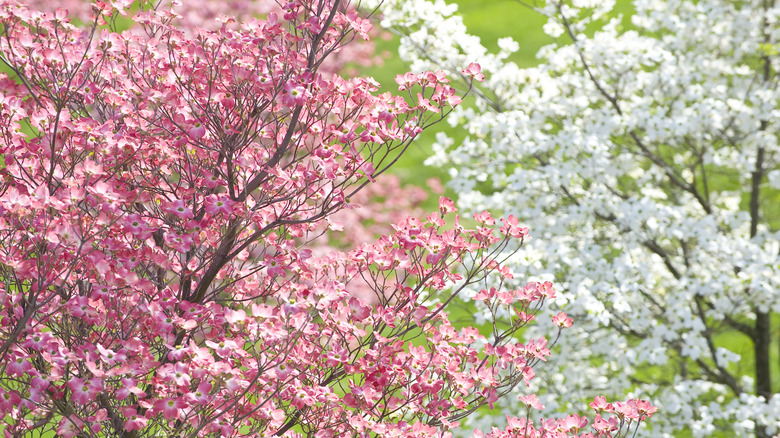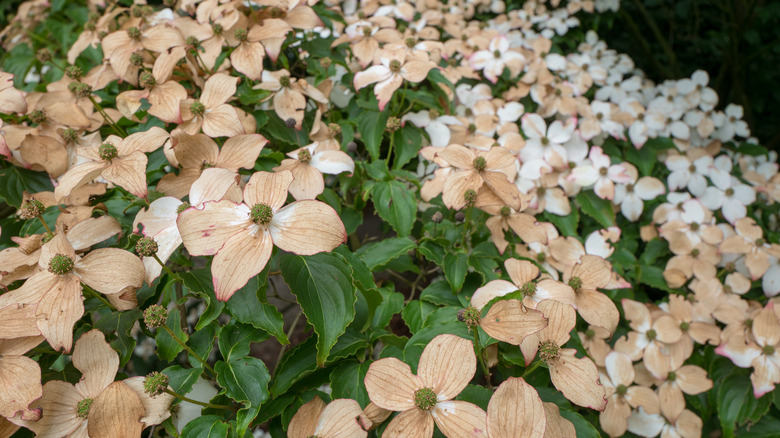Native to the eastern United States, dogwoods are a beloved staple across many regions of the country come springtime, erupting tiny blossoms in various shades of white, pink, and red. But before they can start producing blooms, young dogwoods need to be placed in the proper environment. Additionally, owners should care for dogwood saplings more intently than older trees to ensure they grow to maturity. The best time of year to plant a dogwood tree is early spring when the tree is still premature and the soils underground become more fertile and temperate after a cold winter.
While dogwood trees are pretty to look at during the spring and autumn months, owning one comes with its own advantages. The trees attract pollinators in the summertime when the blossoms from spring are replaced with bright red fruits favored by hummingbirds, bees, and spring azure butterflies. Various woodland mammals like raccoons, foxes, and squirrels also eat the small cherry-like drupes in late summer and early autumn. Additionally, the leaves from the tree drop to the ground after changing color in the fall, disintegrating into the earth to add nutrients to the soil underneath. In order to reap the most benefits from your dogwood tree, plant it in the right soil and give it the correct amount of shade, water, and protection from pests and disease. Continue reading to learn more about the growing conditions of dogwoods and how planting a tree at the wrong time can impact the tree as a whole.
Plant young dogwoods in spring

Planting or transplanting an existing dogwood tree is best accomplished in early spring (or late fall), so the surrounding habitat creates the best possible environment for the tree’s roots to establish underground. These trees thrive when placed in moderate conditions, where they enjoy moist soil, partial shade, and occasional pruning and fertilization. So, planting young dogwoods in their preferred circumstances allows the trees to take root faster and prepares them to handle the extreme weather patterns of the winter and summer months. The new roots of young dogwoods are extremely sensitive and must remain hydrated while exposed, whether the trees are planted in soil or situated above ground waiting to be transplanted. They can take up to a few years to become fully acclimated to the soil once planted, but young trees need to be carefully watched and nurtured during that time until they grow strong and durable enough to withstand rougher conditions outdoors, like droughts and hard freezes.
Correctly timing the planting of a new dogwood tree also ensures that its blossoms will appear in a punctual manner. Don’t expect a young tree to blossom the same year it’s planted, especially if the tree is planted that same spring. But dogwood saplings are expected to start producing blooms by their second year of life and blossom fully by year five. Transplanting before early summer gives your new tree a full year to get used to being in the ground before sprouting flowers.
What happens if you mistime planting a dogwood?

While young dogwood trees can technically be planted during any season, their growing potential — and, in some cases, chances of survival — will be largely limited if planted during the more climatically intense months of winter or summer. Younger trees with less-developed roots are more susceptible to long-lasting damage compared to trees that have fully matured. Hence, planting a dogwood tree at the wrong time can risk exposing it to unnecessary complications at a time when the tree’s buds, bark, and roots aren’t yet strong enough to endure them.
Dogwood trees are naturally inclined to survive cold weather. A physical trait many varieties of dogwoods share is a hardy trunk, which allows them to temporarily withstand freezes of -20 degrees Fahrenheit. However, it may take a few years for young trees to develop a strong tolerance to frigid climates. Conversely, dogwood trees are slightly less capable of protecting themselves from scorching heat, often leaving saplings to succumb to the high temperatures of summer when unprotected. If you choose to plant a dogwood tree during either season, adding mulch around the base of young trees helps regulate their temperature when faced with hot or cold weather. A commonly used insulator within many personal gardens, mulch holds moisture and reflects sunlight during the summer, while keeping the cold air out during the winter.




